In ancient times, in order to try duck meat, people had to hunt these birds. Over time, the ducks were domesticated. As a result of cultivation today, we have a large number of diverse breeds of agricultural waterfowl with different characteristics.
Breeding ducks is rapidly gaining popularity, because duck meat has excellent taste, while the level of egg production is higher than, for example, geese.
When purchasing duck youngsters, after a few months of fattening, it will be possible to serve an appetizing, fragrant, baked duck to the table, however, in order to achieve high performance, it is necessary to follow a number of rules related to feeding and keeping little ducks from the first days of life.
Table of contents
- How to start care?
- What to feed on the first day of life at home?
- Differences in content (care with and without water)
- Table of nutritional rates by period for newborns, daily and weekly ducklings
- How to water the chicks and whether to comply with the temperature?
- How much and how to give vitamins?
- What feed can be used when feeding small chicks?
- Conclusion
How to start care?
Bred ducks, based on the characteristics of a particular breed. Thus, in some breeds, the incubation instincts laid down by nature have completely disappeared under the weight of selection, as a result, breeding such a bird is possible only by placing incubation eggs under another hen, or by laying eggs in an incubator, but certain temperature conditions must be observed .. However, after hatching, questions - how to care for newly hatched ducklings.
Already hatched chicks can be purchased, both daily and older.. It is better to buy young stock from a reliable seller, be it a small farm or a large poultry farm.
The first point to emphasize is the placement of the young. Ducks in general are well tolerated by cold and frost, but for babies in the first days of life, it is required to adhere to temperatures in the region of 27-31 degrees. Initially, the birdies can be placed in a special brooder, avoiding excessive crowding, in the future the grown young animals are transferred to the poultry house.
Since ducks are waterfowl, it is highly desirable to provide them with access to the reservoir. It is desirable that the birds have a small walking. Despite the fact that a number of farmers believe that in order for ducks to gain weight as quickly as possible, they should limit space as much as possiblewhile others, on the contrary, believe that walking and access to a reservoir significantly improves overall performance - the bird is healthier and more resistant.
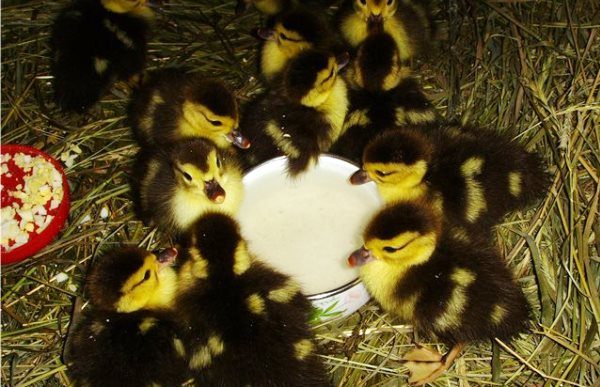
What to feed on the first day of life at home?
The second question that confronts a novice farmer after buying chicks is how to feed the little ducklings in the first days of life. The gastrointestinal tract of ducklings differs from adult individuals, respectively, food suitable for adult ducks, kids will not work.
Ducklings have a higher degree of digestibility of food and a more intense metabolism in comparison, for example, with chickens.
It is necessary to carry out feeding of newborn ducklings 4-5 times a day. Food in the first 2-4 days should be maximally enriched with protein, it helps ducklings grow. For these purposes, mixes are prepared for babies from chopped boiled eggs, cottage cheese with the addition of milk and any fermented milk products such as kefir, yogurt, whey.
Food must be fresh, not eaten leftovers must be disposed of, avoiding damage to food.
In the first days after birth, greens are added to the food in Ptah. In summer, it is better to use fresh, finely chopped. If the growing of ducks is to be in the winter, it is necessary to dry enough greenery in advance for the summer season to add to the mash. For these purposes, nettle, clover, alfalfa and even dandelion are used.
Feeding weekly ducklings
Further, any farmer has a logical question: how to feed weekly ducklings? In addition to the high protein content in food ducks, cereals should be present from the first week. The coefficient of digestibility of grain in them is about 80%, which is even higher than that of chickens.
In addition, the grain also contains protein, about 10-15%. In the first 7-10 days of life, ptakh are given compound feed with the addition of cottage cheese, fermented milk products, finely chopped nettle and other greens. Fresh nettles must be scalded with boiling water before use. Greens contain a number of vitamins necessary for normal growth, development and strengthening of the immune system. Also in the first week it is necessary to enrich the food with mineral substances required by the fast-growing body of the chick. It is possible to try to give the duck feed “Start”.
You may be interested in the following duck articles:
To this end, chalk, fish or meat-and-bone meal, crushed shells or crushed egg shells are added to the feed.Until the second week, mineral dressing is added at the rate of 1 gr. on the head.
Feeding two weeks old chicks
But how to feed ducklings in 2 weeks and how much food to give the question rarely arises. After all, from the second week you can produce young in the presence of walking with access to the reservoir. In this case, the chicks will receive part of the food in their natural environment. Feed them will need only twice a day - in the morning and evening.
In the morning, two weeks old chicks are fed not to fill up, so that the babies themselves can get enough for a walk. When birds are in an enclosed space, the feed load increases.
Cottage cheese and eggs are removed from the mash, replacing boiled root vegetables, such as potatoes, sugar beets, and carrots. In winter, from the second week, the ducks can be fed with a combined silo. The main part of the feed at this stage is the feed, a little smaller part - greens.
At this age, to improve digestion and stimulate bowel movements, farmers add a little sand or small gravel to the feed.
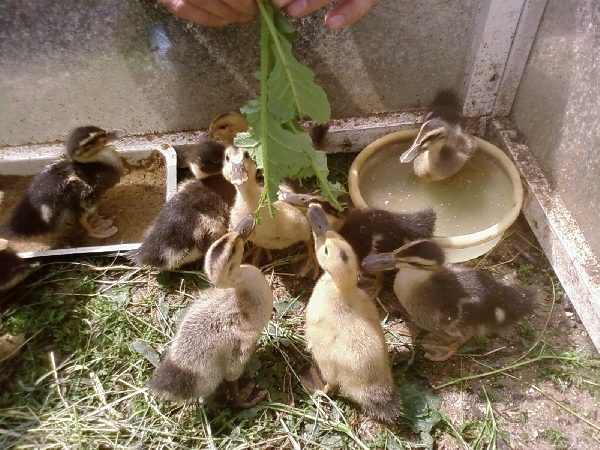
Differences in content (care with and without water)
Ideally, ducks should have access to water. Any pond or small river with a weak current and grass along the shore will do. In this case, there is practically no need for additional feeding with vitamins and minerals, as ducks will receive the necessary supplements to the diet from a natural source of the environment. In addition, the presence of a reservoir can significantly reduce feed costs.
Of course, in the conditions of a harsh winter, when the reservoirs are covered with ice, the birds are not able to get their food. Therefore, the cost of keeping ducklings in winter will be higher even with the presence of a reservoir. Unfortunately, not always and not every yard has a pond, stream or river in the neighborhood.
Table of nutritional rates by period for newborns, daily and weekly ducklings
More complete information on how the ducks are fed in the first periods of life can be obtained from the table:
| Age of young stock (in days) | |||
| Stern | 1-10 | 11-20 | 21-30 |
| Feed | 25 | 70 | 110 |
| Greens (fresh) | 15 | 60 | 90 |
| Combined Silo (Winter) | __ | 10 | 20 |
| Roots | __ | 10 | 15 |
| Eggs | 3 | __ | __ |
| Cottage cheese | 3 | __ | __ |
| Duckweed | __ | 15 | 5 |
| Meat-bone (fish) flour | 0,5 | 1,5 | 3 |
| Nettle (dry) | 0,5 | 1 | 3 |
| Nutrient Yeast | 0,2 | 0,5 | 0,8 |
| Seashells, eggshell | 0,5 | 1,5 | 3 |
| a piece of chalk | 0,1 | 0,3 | 0,5 |
| Food waste | __ | 15 | 40 |
| Gravel (coarse sand) | __ | 0,5 | 1 |
| Digestible Proteins | 4,6 | 13 | 19 |
| Food in units (gr) | 31 | 82 | 134 |
| Live weight of ducklings in grams | 200 | 500 | 800 |
But the table of the norms of the content of nutrients contained in 100g of combined feed:
| Age of ducklings, weeks | Exchange energy | Crude protein, g% | Crude fiber, g% | Calcium, mg | Phosphorus, mg | Sodium, mg | |
| kJ | kcal | ||||||
| 1 | 1250 | 298 | 22 | 4 | 1200 | 800 | 400 |
| 2-3 | 1193 | 285 | 20 | 4 | 1200 | 800 | 400 |
| From 3 to the end of the growth. | 1277 | 305 | 17 | 5 | 1200 | 800 | 400 |
How to water the chicks and whether to comply with the temperature?
A prerequisite is the availability of clean water to drink. Water should not be cold. The temperature of the drinking water should be around 20 degrees. Drinking bowls should be provided in such a way that the chicks could not climb into them, otherwise the water will inevitably be quickly contaminated.
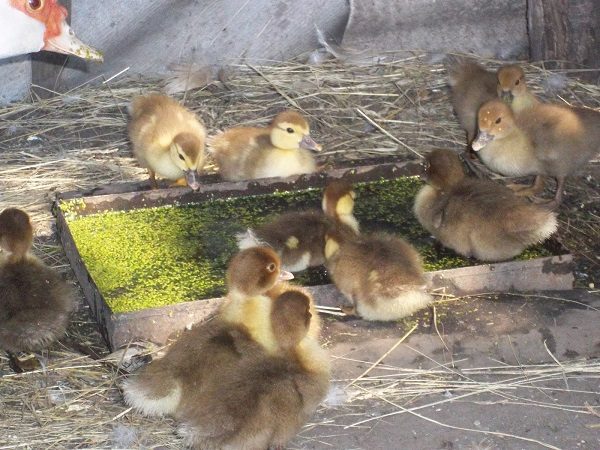
You can buy ready-made drinkers, you can make it yourself, making a slot in a plastic bottle, for example, or you can place an inverted jar of water in a plate, as shown in the figure:
How much and how to give vitamins?
Vitamins are essential for normal development and functioning.The need for additional feeding with vitamins disappears, provided that from the first days the birds have a balanced diet and from the second week have access to the natural natural reservoir, they are sufficiently in the sun. In such a situation, ducks independently replenish stocks of the required substances.
If the ducks are found exclusively in the house, you will have to artificially compensate for the lack of vitamins by adding vitamin-containing components to the feed.
To prevent the disease, it is recommended to add fish oil to the mash, or synthetic vitamins acquired in vet pharmacies.
The vitamins of other groups of ducklings get along with greens. Especially a lot of them contained in the nettle. In cases where adding fresh greens to the feed is not possible, the use of synthetic vitamin complexes is recommended.
What feed can be used when feeding small chicks?
The most suitable starting feed for ducklings of the first twenty days of life is PK-21. Combined food for this age group of waterfowl best meets the needs of the body at this stage.
Since food of waterfowl in its natural environment is predominantly wet, for ducklings kept at home it is desirable to additionally wet the feed with milk, whey or meat broth. Such a mixture belongs to the category of perishable, therefore, in cases where the chicks have not fully consumed food, the feeders must be cleaned of residues. Monthly ducklings are recommended to transfer to the combined feed PK-22.
The composition of the feed PK-21:
| The composition of the recipe | % |
| Wheat | 33,54 |
| Corn | 25 |
| Extruded soy | 2 |
| Bran | 5 |
| Soybean cake | 12 |
| Sunflower cake | 17 |
| a piece of chalk | 2,4 |
| Fish flour | 0,5 |
| Monocalcium phosphate | 0,85 |
| Salt cooks. | 0,3 |
| Lysine | 0,27 |
| Methionine | 0,14 |
| Premix (enzyme) | 1 |
| 100 |
| Guaranteed performance | % |
| Humidity | 12,5 |
| Crude Fiber | 6 |
| Crude protein | 18,5 |
| Raw fat | 6,26 |
| Exchange energy, kcal | 282 |
| Methionine + cystine | 0,77 |
| Methionine | 0,47 |
| Lysine | 1 |
| Threonine | 0,63 |
| Calcium | 1,1 |
| Common phosphorus | 0,7 |
| Sodium | 0,16 |
The composition of the feed PK-22:
| The composition of the recipe | % |
| Wheat | 53,817 |
| Corn | 15 |
| Sunflower cake | 19,5 |
| Soybean cake | 2 |
| Extruded soy | 4,8 |
| Monocalcium phosphate | 0,9 |
| a piece of chalk | 2,4 |
| Salt cooks. | 0,28 |
| Lysine | 0,27 |
| Methionine | 0,033 |
| Premix | 1 |
| 100 |
| Guaranteed performance | % |
| Humidity | 12,5 |
| Crude Fiber | 5,8 |
| Crude protein | 16,8 |
| Raw fat | 5,6 |
| Exchange energy, kcal | 295 |
| Methionine + cystine | 0,68 |
| Methionine | 0,35 |
| Lysine | 0,87 |
| Threonine | 0,57 |
| Calcium | 1,1 |
| Common phosphorus | 0,65 |
| Sodium | 0,18 |
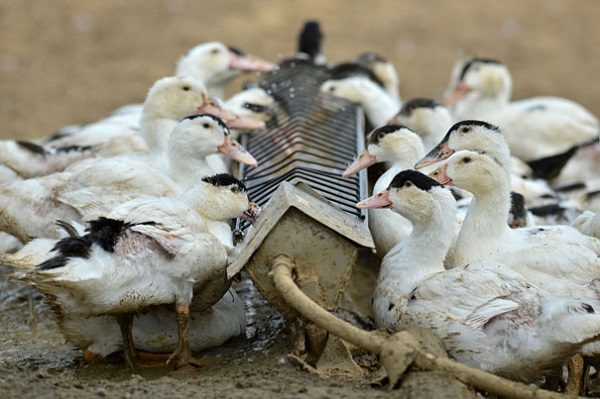
Starter feed with their own hands for monthly ducklings
A couple of ways to prepare a combined feed for young animals at the age of one month on their own. Method one. For cooking you will need to mix:
- 45% corn;
- 17% sunflower meal;
- 13% wheat;
- 8% barley;
- 5% feed yeast;
- 4% fish meal;
- 3% feed fat;
- 1% meat and bone meal;
- 1% herbal flour and chalk.
Another recipe for self-cooking:
- 51% corn;
- 19% wheat bran;
- 19% cake (soybean or sunflower);
- 4% wheat;
- 2.4% feed fat;
- 1.7% defluorinated phosphate (tricalcium phosphate);
- 1.5% shell (or eggshell);
- 1% feed yeast;
- 0.4% salt.
Conclusion
The main value of ducks as poultry is in the taste properties of duck meat. In addition, these birds are a source of fluff, which is valued everywhere and is used for warming clothes, filling feather beds.
Duck down is not as soft as that of geese, but the thermal insulation properties are just as good. And from the ducks get eggs, richer in composition than chicken. For the successful breeding of poultry in order to obtain high-quality meat, eggs and down, it is extremely important to responsibly approach the issue of feeding and caring for the young from the very birth.
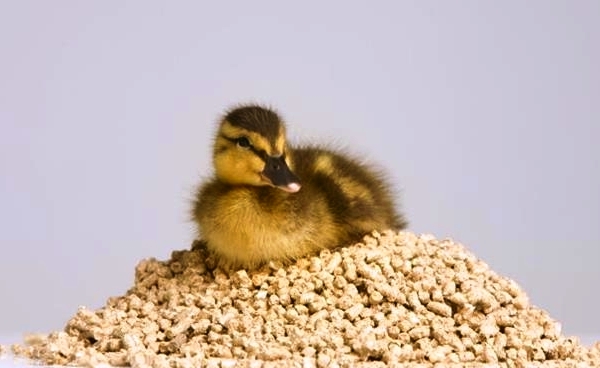
From pluses quickly grow. The grandmother fed with wheat plus a cut grass with compound feed. Access to water was constant. Only from them there is a lot of dirt and noisy. I like shyuny more in this regard.